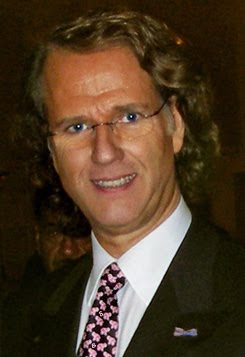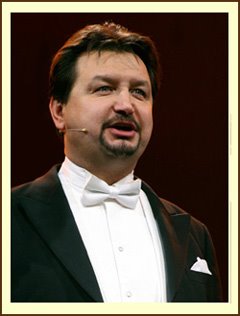December 11, 2007
Arizona Daily Star
André Rieu marched the members of his Johann Strauss Orchestra down the center aisle of the Tucson Arena Sunday night, leading them through a throng of audience members who had sprung to their feet at the first notes of a prerecorded waltz.
Up the center stage stairs they marched, their instruments in hand — even the tuba player. The men wore tuxedos, the women brilliantly colored flowing gowns, with long-sleeve white fur waistcoats.
This was not your ordinary classical music concert, to be sure.Sure it had all the kitsch you would expect from an ensemble whose calling card was waltzes and ages-old German folk songs about drinking and love.But here's the thing: At least 4,000 people — young, old, ethnically diverse — turned out on a chilly Sunday evening in December to hear classical music.
Just ask the Tucson Symphony Orchestra, which plays the 2,289-seat Music Hall next door, if they would like to see that many people show up. They would be lying if they said no.
The attraction? Rieu (Ree-You), a dynamic, entertaining music-maker who has knocked classical-music convention on its hind end so that folks like the dozens of young kids attending Sunday night can feel comfortable listening to hundreds-year-old music.
"What would the world be without music? Music is the most beautiful thing in life," Rieu told the audience, then set out for the next 2 1/2 hours to prove the point with a rock-show worthy cast that included five female backup singers, a trio of superb sopranos and the breathtaking Platinum Tenors.
On a stage decorated with a half-dozen towering Christmas trees, the orchestra performed primarily Strauss waltzes, including the romantic "Roses from the South" and the playful "Tritsch-Tratsch-Polka."
Rieu accompanied on violin and conducted the players from center stage with quick nods. His smile grew bigger every time the players, most of them likely in their 20s, made the music of Rieu's hero sing with warmth and sincerity. He smiled a lot.
And if you were paying attention to the players — hard not to since the concert was broadcast on two large screens framing the stage — you saw how much fun they were having. Throughout the concert, whether playing an uptempo, playful waltz or a somber love song, the players smiled. The cellist closest to the audience bobbed her head to the tune; two violinists, a man and a woman sitting next to each other, nodded at one another in time to the music. Sometimes, one would rock forward, the other backward, never missing a note as they played.
The show combined amazing vocal turns with sterling musical moments, including a breath-stealing performance of Ravel's "Boléro." The piece started with the rat-tat-tat of the snare drum setting the theme and the melody introduced by the piccolo then carried through by the flutes while the string section played pizzicato to create a resonating thump.
The Platinum Tenors paid tribute to the late great tenor Luciano Pavarotti by singing "Nessun Dorma," one of Pavarotti's signature arias from Puccini's opera "Turandot." And each of the three sopranos sang solos, including Australian Mirusia Louwerse's dreamy version of "Wishing You Were Somehow Here Again" from "Phantom of the Opera."
But the thing that really sets André Rieu apart from his classical-music peers is the way he invites — almost insists — that the audience be as much a part of the evening as he and his musicians.When the ensemble launched into Christmas carols, he instructed the audience to sing along. But . . ."We're going to play this song three times. The first time we play it, you shut your mouth," he explained, and the audience laughed. "The second time you hum the melody. The third time, you sing along."Then the orchestra played a very melancholic "Silent Night" and the audience was quiet as mice. Lights twinkled against a darkened screen running the length of the stage back as the orchestra played it a second time and the audience hummed the melody, creating a surreal "Miracle on 42nd Street" moment. On the third time, they sang along, quietly, almost as if they were all holding candles and caroling door-to-door.
The serious moment was short-lived when the orchestra lit into "White Christmas." High above the center of the arena, big clumps of finely shredded paper "snow" floated down, gently at first then thick, like a Buffalo, N.Y., blizzard."You asked to sit there," Rieu said afterward, as audience members got up to shake off.
Of course no self-respecting Johann Strauss ensemble could call it a night without performing "The Blue Danube Waltz." And no self-respecting fan of the waltz can sit still for that.Dozens of couples abandoned their seats and took to the aisles to dance. Some, like the finely dressed gray-haired couple waltzing in front of the stage, were graceful and refined. A few looked a little clumsy.But it didn't matter. The music moved them. And that was Rieu's point.
Thank you to John, Bobbie and Suzie for sending this. :)






































































































































No comments:
Post a Comment